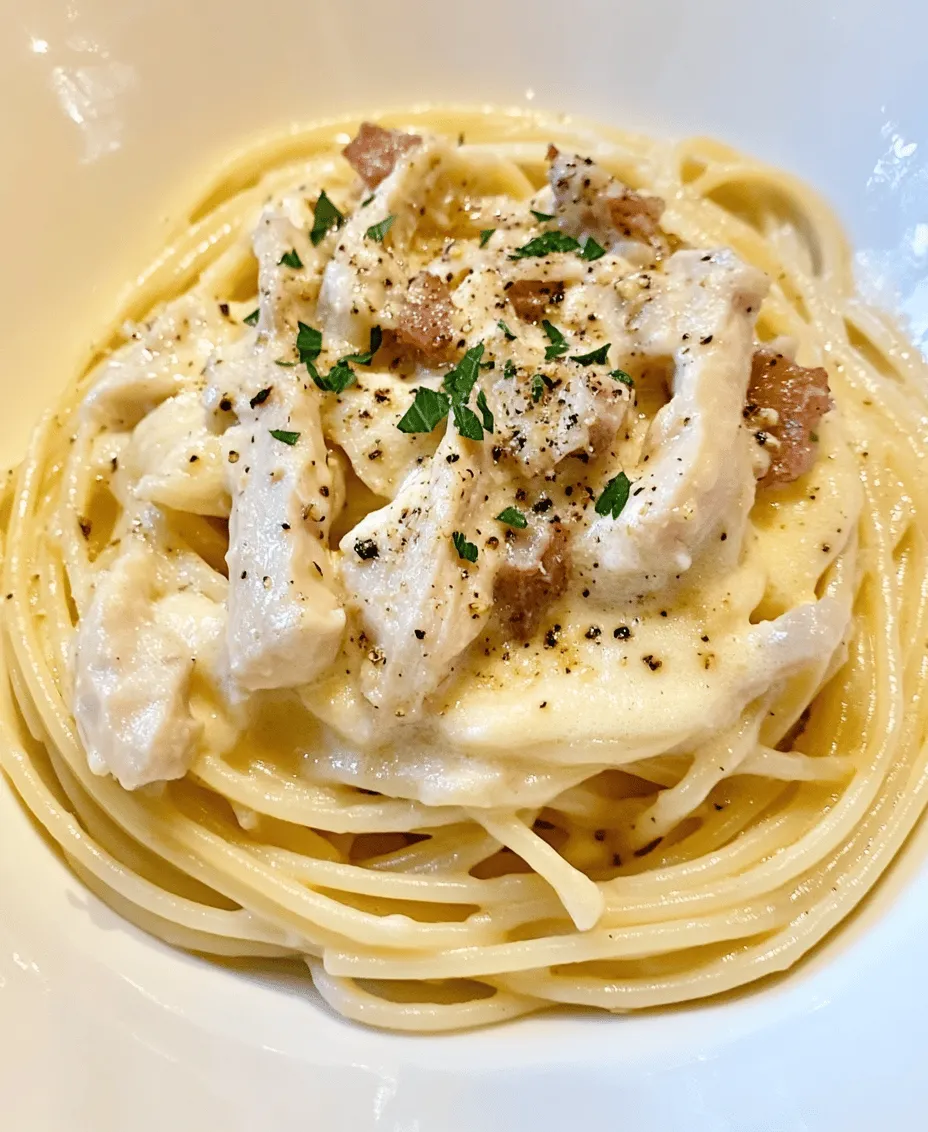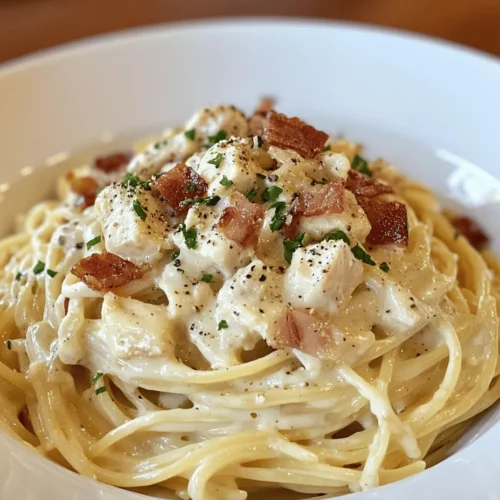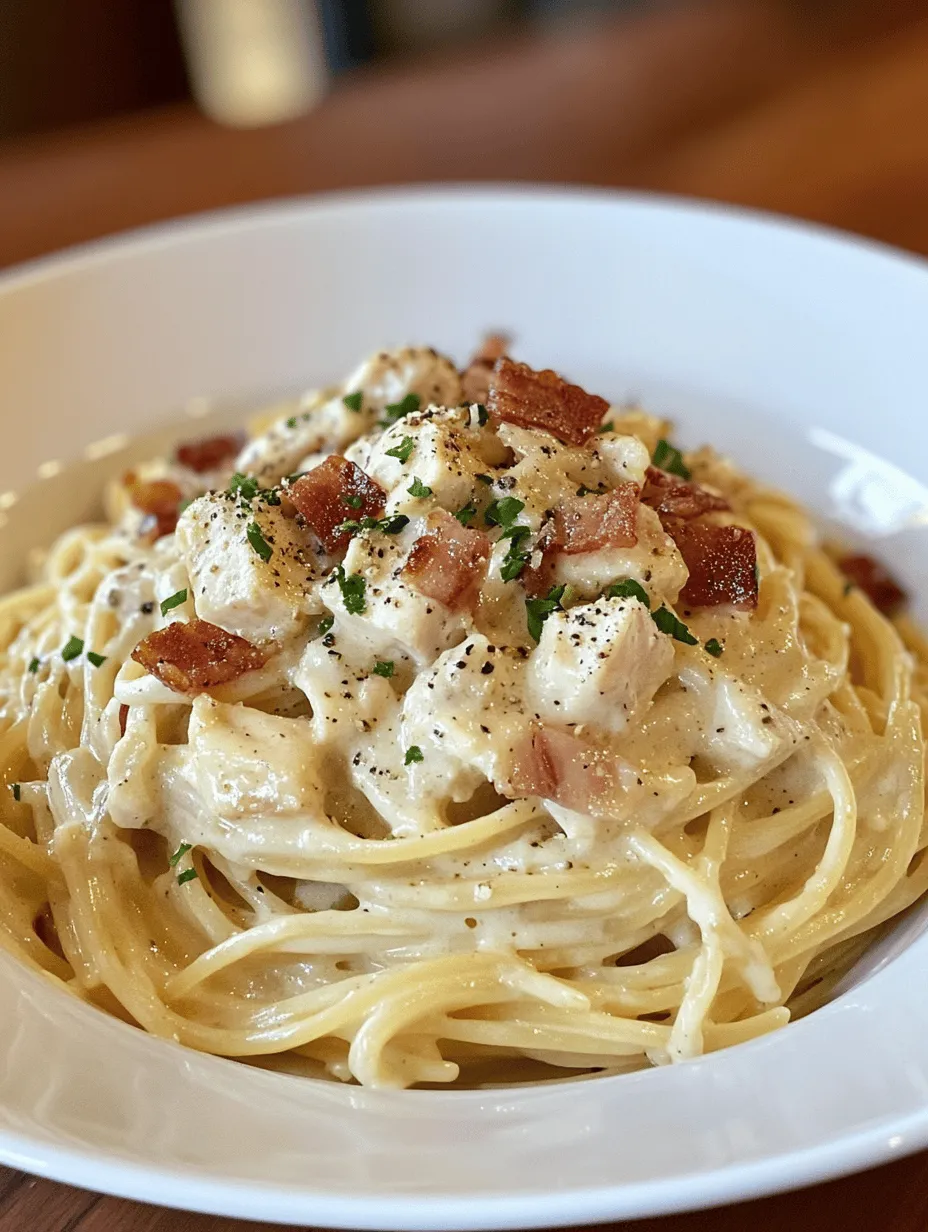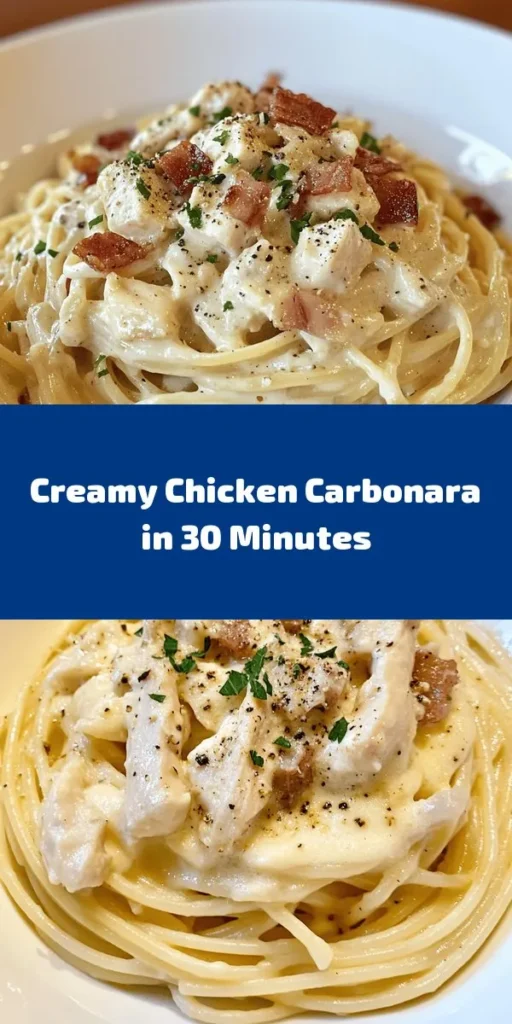Introduction
Chicken Carbonara is a delightful twist on the classic Italian dish that has captured the hearts and taste buds of food lovers around the world. Traditionally, Carbonara features a simple yet rich combination of ingredients, including pasta, eggs, cheese, and pancetta, all of which come together to create a creamy sauce that clings beautifully to the noodles. In this version, we elevate the dish by incorporating tender chicken, adding protein and making it a complete meal that’s perfect for any occasion.
The appeal of Chicken Carbonara lies in its luscious sauce, which balances creaminess with savory flavors. The combination of perfectly cooked pasta and succulent chicken results in a dish that is both comforting and satisfying. However, the true essence of Chicken Carbonara comes from the quality of its ingredients. Using fresh, high-quality components not only enhances the dish’s flavor but also pays homage to its Italian roots.
In this article, you will learn everything you need to know to prepare the best-ever Chicken Carbonara. From step-by-step instructions to tips for perfecting this dish, we will guide you through the cooking process. Additionally, we will explore the cultural significance of Carbonara, giving you insight into this beloved recipe’s history.
Understanding Chicken Carbonara
Origin of Carbonara
The origins of Carbonara are somewhat shrouded in mystery, with various theories surrounding its inception. Some food historians trace its roots back to the 1940s in Rome, where it was created by Italian coal workers, known as “carbonari.” This association with coal workers led to the name “Carbonara,” derived from the Italian word “carbone,” meaning coal. Others suggest that the dish was influenced by American soldiers stationed in Italy after World War II, who introduced bacon and eggs to the local cuisine.
Regardless of its origins, Carbonara has become a staple in Italian cooking, and its popularity has spread globally. The traditional recipe typically includes spaghetti, guanciale (cured pork cheek), eggs, cheese, and black pepper. Each ingredient plays a crucial role in creating the dish’s signature flavor profile.
Traditional Ingredients vs. Variations
While Chicken Carbonara deviates from the traditional recipe by incorporating chicken, it still maintains the essence of the original dish. The main components of a classic Carbonara include:
– Pasta: Typically, spaghetti or rigatoni is used for its ability to hold the sauce.
– Guanciale: This is the traditional cured meat, although pancetta or bacon can serve as substitutes.
– Eggs: Essential for creating the creamy sauce.
– Cheese: Pecorino Romano is the classic choice, providing a distinct flavor.
In our Chicken Carbonara recipe, we replace guanciale with either pancetta or bacon, adding chicken to enhance the dish’s heartiness. This variation allows for a delightful twist while preserving the dish’s creamy, savory characteristics.
The Role of Each Ingredient
Understanding the role of each ingredient is key to achieving the perfect Chicken Carbonara. Here’s a breakdown of the essential components:
– Pasta (Fettuccine or Spaghetti): The choice of pasta can significantly affect the dish’s texture. Fettuccine is wider and offers a chewier bite, while spaghetti is the classic choice for Carbonara.
– Chicken Breasts: Using boneless, skinless chicken breasts ensures a lean protein source that cooks quickly and absorbs the flavors of the sauce.
– Eggs: Fresh eggs are vital for creating the creamy sauce that binds the pasta and chicken together. The yolks add richness, while the whites help achieve the desired consistency.
– Pecorino Romano Cheese: This cheese is sharp and salty, perfectly complementing the other ingredients. If unavailable, Parmigiano-Reggiano can be used, but it will slightly alter the flavor.
– Pancetta or Bacon: Pancetta is a traditional Italian cured meat that provides a rich flavor, while bacon offers a smoky taste. Choosing between the two will depend on your preference for flavor.
– Garlic: A small amount of garlic enhances the overall flavor without overpowering the dish.
– Olive Oil: Extra virgin olive oil is ideal for cooking as it adds a fruity note that complements the other ingredients.
– Seasoning: Salt and freshly cracked black pepper are essential for balancing the flavors in this dish.
Ingredients Breakdown
To prepare the best-ever Chicken Carbonara, you will need the following ingredients, each carefully selected to create a delicious meal.
Fettuccine or Spaghetti
The first step in preparing Chicken Carbonara is selecting the right pasta. Fettuccine and spaghetti are two popular choices, but each brings a unique texture to the dish. Fettuccine, with its flat and wide shape, offers a satisfying chew and holds onto the creamy sauce exceptionally well. On the other hand, spaghetti is a classic choice that pairs beautifully with the rich flavors of Carbonara. Whichever pasta you choose, ensure it is of high quality for the best results.
Chicken Breasts
For this recipe, boneless, skinless chicken breasts are recommended for their tender texture and ability to absorb flavors. It’s essential to season the chicken properly and cook it until golden brown to achieve maximum flavor. Additionally, if you prefer a more robust taste, you can marinate the chicken in olive oil, garlic, and herbs before cooking.
Eggs
Fresh eggs are a cornerstone of Chicken Carbonara, as they are responsible for creating the sauce’s creamy texture. The richness of the yolks adds depth, while the whites contribute to the overall consistency. Always choose the freshest eggs you can find, as their quality directly impacts the dish’s final flavor.
Pecorino Romano Cheese
Pecorino Romano is a salty, hard cheese made from sheep’s milk, and it is the traditional cheese used in Carbonara. Its distinct flavor elevates the dish, providing a savory bite that complements the creaminess of the sauce. If Pecorino Romano is hard to find, you can substitute it with Parmigiano-Reggiano, though the flavor will differ slightly.
Pancetta or Bacon
The choice between pancetta and bacon is crucial in shaping the dish’s flavor. Pancetta is an Italian cured meat that imparts a rich, savory taste, while bacon adds a smoky flavor. Both options work well in Chicken Carbonara, but if you’re aiming for authenticity, pancetta is the way to go. Cook the meat until it’s crispy to add texture to the dish.
Garlic
Garlic is a versatile ingredient that enhances the flavor profile of Chicken Carbonara. Using fresh garlic will impart a fragrant aroma without overwhelming the dish. Aim for a subtle garlic flavor that complements the richness of the sauce.
Olive Oil
The quality of olive oil used in this recipe can make a significant difference. Extra virgin olive oil is the best choice for its fruity and robust flavor. It not only helps cook the chicken but also adds depth to the overall dish.
Seasoning
Lastly, seasoning is crucial for balancing the flavors in Chicken Carbonara. Salt enhances the savory elements, while freshly cracked black pepper adds a hint of heat. Be cautious with the amount of salt, especially if you’re using pancetta or cheese, as both are naturally salty.
Step-by-Step Preparation Guide
Now that you have a good understanding of the ingredients, let’s dive into the preparation process. The following steps will guide you through cooking the best-ever Chicken Carbonara.
Cooking the Pasta
1. Salting the Water: Start by bringing a large pot of water to a boil. Once boiling, generously salt the water. This step is crucial, as it’s your only chance to season the pasta itself. The water should taste like the sea.
2. Cooking Al Dente: Add your choice of fettuccine or spaghetti to the boiling water. Cook according to package instructions, but aim for al dente texture, which means the pasta should be firm to the bite. This will ensure it holds up well when mixed with the sauce.
3. Reserving Pasta Water: Before draining the pasta, reserve about a cup of the starchy cooking water. This water is an essential ingredient for achieving a creamy consistency in the sauce. Set it aside for later use.
Cooking the Chicken
1. Preparing the Chicken: While the pasta is cooking, prepare the chicken breasts. Pat them dry with paper towels to remove excess moisture, which helps achieve a golden crust during cooking. Season both sides generously with salt and freshly cracked black pepper.
2. Heating the Pan: In a large skillet, heat a couple of tablespoons of olive oil over medium-high heat. Once the oil is shimmering, carefully add the seasoned chicken breasts to the pan.
3. Achieving Golden, Juicy Chicken: Cook the chicken for about 5-7 minutes on each side, or until it is golden brown and cooked through. Use a meat thermometer to ensure the internal temperature reaches 165°F (75°C). Once cooked, transfer the chicken to a cutting board and let it rest for a few minutes before slicing it into bite-sized pieces.
With the pasta cooked and the chicken ready, you’re well on your way to creating a delectable Chicken Carbonara. Stay tuned for the next part, where we will dive into creating the creamy sauce and combining all the components for the final dish.

Importance of Seasoning During the Cooking Process
Seasoning is a fundamental aspect of cooking that elevates the flavors of any dish, and Chicken Carbonara is no exception. Proper seasoning not only enhances the taste but ensures that each ingredient shines through. When cooking the chicken, for instance, adding a pinch of salt and pepper at the beginning allows the flavors to penetrate the meat. Similarly, seasoning the pasta water is crucial; a well-salted pot of water ensures that the pasta absorbs flavor as it cooks, setting the stage for a delicious final dish.
Sautéing the Pancetta
One of the key components of Chicken Carbonara is pancetta, a type of Italian bacon that adds depth and richness to the dish. To achieve that perfect balance of crispy and tender, pay attention to your sautéing technique.
Tips for Achieving the Perfect Crispiness
1. Use the Right Pan: A heavy-bottomed skillet is ideal for even heat distribution. Cast iron or stainless steel skillets work well for this purpose.
2. Don’t Overcrowd the Pan: Sauté the pancetta in batches if your skillet isn’t large enough. Overcrowding can cause steaming instead of crisping.
3. Medium Heat: Start cooking on medium heat to render the fat slowly, allowing the pancetta to become crispy without burning.
4. Patience is Key: Resist the urge to stir constantly. Let the pancetta sit for a minute or two before turning it to develop a good crust.
Timing Garlic Addition for Optimal Flavor
Once the pancetta is crispy and golden, it’s time to add garlic. Timing is crucial here; adding garlic too early can lead it to burn, resulting in a bitter flavor. Instead, wait until the pancetta has released its fat and is nearly done. Add minced garlic to the skillet and sauté for about 30 seconds, just until fragrant. This step brings a wonderful aroma and flavor that perfectly complements the richness of the pancetta.
Preparing the Sauce
The creamy sauce of Chicken Carbonara is what makes this dish truly special. Creating it requires a delicate balance of ingredients and technique.
Whisking Technique for a Smooth Mixture
To prepare the sauce, whisk together egg yolks, grated Parmesan cheese, and a generous amount of freshly ground black pepper. Using a whisk instead of a fork allows for a smoother, more homogeneous mixture, which is essential for a creamy sauce. Ensure the ingredients are well combined, creating a silky texture that will cling to the pasta.
Balancing Flavors with Black Pepper
Black pepper plays a critical role in Carbonara, providing a spicy kick that balances the richness of the sauce. Be generous with it, but taste as you go. Remember, you can always add more, but you can’t take it out once it’s in! A high-quality, fresh black pepper will elevate your dish, so consider using a pepper mill to achieve the best flavor profile.
Combining Ingredients
Once your pasta is cooked and your sauce is ready, it’s time to bring everything together.
Importance of Removing the Skillet from Heat Before Adding the Sauce
Before you combine the pasta with the pancetta and garlic, remove the skillet from heat. This step is crucial to prevent the eggs from scrambling when they come into contact with the hot mixture. The residual heat from the pasta will cook the eggs gently, allowing for a creamy sauce rather than scrambled eggs.
Tips for Effectively Tossing Everything Together
1. Use Tongs: A pair of tongs is your best friend for tossing the pasta with the pancetta and garlic. It allows for gentle mixing without breaking the pasta.
2. Add the Sauce Gradually: Pour the egg and cheese mixture over the pasta a little at a time, tossing gently to coat the strands evenly.
3. Incorporate Pasta Water: If the sauce appears too thick, add a splash of reserved pasta water, stirring until you reach the desired consistency. This step not only adjusts the thickness but also helps the sauce adhere to the pasta.
Creating the Perfect Creamy Sauce
The hallmark of a great Chicken Carbonara is its creamy sauce, which hinges on the correct interaction between the egg and cheese mixture and the heat from the pasta.
Understanding the Science Behind the Egg and Cheese Mixture
The key to a luscious sauce lies in the emulsification of the egg yolks and cheese. As you mix the hot pasta with the egg mixture, the heat cooks the yolks gently, creating a creamy texture. It’s essential not to rush this process; the goal is to create a velvety sauce that clings to every strand of pasta.
How the Residual Heat of Pasta Cooks the Eggs Without Scrambling
When you add the egg mixture to the hot pasta, the residual heat works its magic. The gentle warmth cooks the eggs just enough to thicken the sauce without scrambling them. This is why it’s critical to remove the skillet from direct heat and to combine the ingredients quickly while the pasta is still hot.
Adjusting Consistency with Reserved Pasta Water
Pasta water is a chef’s secret weapon. It contains starch released by the pasta during cooking, which helps in emulsifying the sauce. If your sauce seems too thick or dry, gradually add a tablespoon or two of reserved pasta water until you achieve the desired creamy consistency. This technique not only improves texture but also enhances flavor.
Plating and Serving Suggestions
Presentation is key when serving Chicken Carbonara, as a beautifully plated dish is more appetizing.
Presentation Tips for an Appealing Dish
1. Use a Large Serving Bowl: A large bowl allows you to create a nice twirl of pasta, making it visually appealing.
2. Twirl the Pasta: Use a fork or tongs to twirl the pasta into a nest shape for a restaurant-style look.
3. Layering: Consider layering the pancetta and garlic on top of the pasta for a rustic look.
Garnishing with Parsley and Cheese: Importance of Visual Appeal
Finishing touches can make all the difference. A sprinkle of freshly chopped parsley not only adds a pop of color but also a fresh flavor that cuts through the richness. Additionally, a generous grating of Parmesan or Pecorino Romano cheese on top enhances the dish’s visual appeal and adds an extra layer of flavor.
Suggested Pairings: Wine, Sides, or Salads That Complement Chicken Carbonara
To elevate your Chicken Carbonara experience, consider pairing it with a crisp white wine like Pinot Grigio or a light red like Chianti. These wines complement the creaminess of the dish without overpowering it. For sides, a simple arugula salad with lemon vinaigrette provides a refreshing contrast. Garlic bread is another excellent choice, perfect for soaking up any extra sauce.
Nutritional Information
Understanding the nutritional value of your meals can help you make informed dietary choices.
Breakdown of Calories, Protein, and Fats Per Serving
A typical serving of Chicken Carbonara (approximately 1 cup) contains about 550 calories, 30 grams of protein, and 25 grams of fat. The protein primarily comes from the chicken and eggs, while healthy fats are derived from the pancetta and cheese.
Discussion on the Dish’s Nutritional Value and Potential Modifications for Healthier Options
While Chicken Carbonara is undeniably delicious, it can be rich in calories and fats. To lighten it up, consider using whole grain or low-carb pasta options. You can also reduce the amount of pancetta or substitute it with turkey bacon for a leaner choice. Incorporating additional vegetables such as peas or spinach can boost the dish’s fiber content and add essential nutrients.
Conclusion
Chicken Carbonara is a beloved comfort food that has stood the test of time, captivating palates with its creamy texture and rich flavors. The combination of crispy pancetta, perfectly cooked pasta, and a luscious sauce creates a satisfying dish that is perfect for any occasion.
Experimenting with variations, such as adding vegetables or trying different types of cheese, can add a personal touch while still respecting traditional roots. The joy of sharing a homemade Chicken Carbonara with family and friends makes the effort worthwhile, creating lasting memories around the dinner table.
Mastering this classic recipe not only enhances your culinary skills but also brings the comforting taste of Italy into your home. So, gather your ingredients, follow these steps, and enjoy the satisfaction of creating a dish that is sure to impress.



